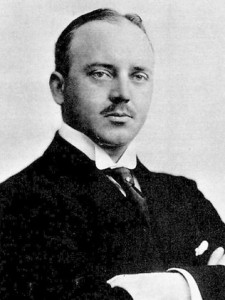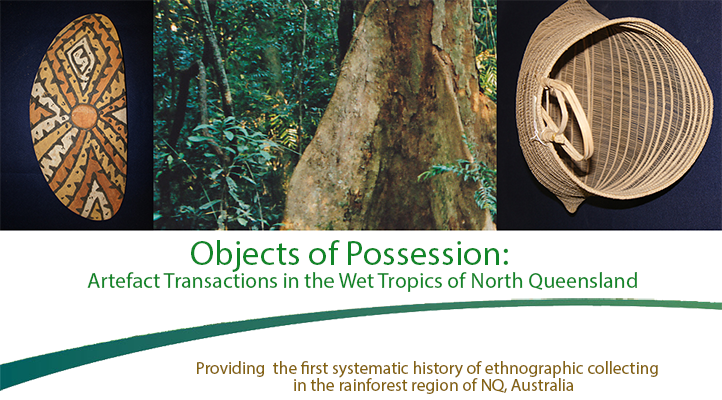
Eric Mjöberg. Source: http://www.theaustralian.com.au/arts/review/beautiful-and-broken-forever-in-the-eyes-of-eric-mjoberg/story-fn9n8gph-1226582888695
Author: Russell McGregor
Collector: Eric Georg Mjöberg
Born: 6 August 1882 in Ås, Hall, Sweden
Died: 8 July 1938 in Stockholm, Sweden
Active: Mjöberg collected in the Wet Tropics, mainly on the Atherton Tableland but also in the coastal strip between Cairns and Babinda, from January to July 1913.
Background biography: Swedish entomologist Eric Mjöberg made two biological and ethnographic collecting expeditions to Australia. The first, in 1910-11, took him to the Kimberleys in Western Australia, where his ransacking of graves in search of Aboriginal skeletal remains would later inspire pejorative depictions of a man who practised a ‘dark science’. On his second trip to Australia in 1912-13, he spent six months collecting in the Wet Tropics of North Queensland. He may have collected skeletal remains there too (the evidence is unclear), but he certainly collected a large number (around 200) items of material culture, including the distinctive wooden swords, painted shields, bicornual baskets, stone morahs and beaten bark blankets of the rainforest region.
Grave-robber though he was, Mjöberg viewed Aboriginal people sympathetically. His account of the inhabitants of the Wet Tropics is suffused with a Romantic admiration for people who lived close to nature. The ‘tribes that inhabit the immense rainforests in north Queensland’, he enthused, ‘have adapted themselves very well to the dense jungle vegetation’, where they ‘exist in harmony with all other creatures and elements in the huge and multifarious realm of nature’. Mjöberg interpreted rainforest material culture in accordance with this vision of a people living harmoniously with the natural environment.
Unlike many of his contemporaries, Mjöberg attributed Aboriginal people with an aesthetic sensibility similar to that of Europeans. He observed that on rainforest shields, the ‘colours are applied in the most fantastic patterns. Some of the large wooden shields that I brought back from the Mulgrave Valley, where the Aborigines were particularly fond of beautiful and brilliant colours, show actual cubistic and futuristic tendencies, quite comparable to Grünewald’s most extraordinary works’. (The artist to whom Mjöberg referred was the Swedish modernist, Isaac Grünewald, 1889-1946, not the better-known German Renaissance painter, Matthias Grünewald.)
Mjöberg adhered to a theory of Aboriginal origins that positioned them as a primitive branch of the Caucasian race and thus biologically closely related to Europeans. It was a theory widely endorsed by scientists in the early twentieth century, both in Australia and internationally. He also adhered to the equally widely-held belief that Aboriginal people could not survive contact with Western civilisation. The only way to save them from utter annihilation, he insisted, was to shut them away from other races and allow them to follow their ancestral ways unhindered. Mjöberg had a particular animus against missionaries, whose attempts to Christianise and civilise he condemned as merely expediting Aboriginal extinction.
Mjöberg was among the first anthropologists to regard the inhabitants of the North Queensland rainforests as somehow distinct from other Aboriginal peoples. He saw that distinctiveness in terms of their material culture and mode of subsistence in a biological environment quite different to that of other parts of Australia. Unlike later theorists Norman Tindale and Joseph Birdsell, Mjöberg did not suggest that the people of the rainforests were members of a distinct race, but rather that the rainforest environment elicited particular adaptations from the people who lived there. That interpretation, which stemmed from his adherence to Darwinian evolutionism, is congruent with generally-accepted notions of rainforest Aboriginal distinctiveness today.
Sources: Åsa Ferrier, ‘Dr Eric Mjöberg’s 1913 Scientific Exploration of North Queensland’s Rainforest Region’, Memoirs of the Queensland Museum, Cultural Heritage Series, vol.4, no.1, 2006, pp.1-27.
Dark Science, documentary film directed by Johan Gabrielsson & Warwick Thornton, 2008.
Russell McGregor, Imagined Destinies: Aboriginal Australians and the Doomed Race Theory, 1880-1939, Melbourne University Press, 1997.
Eric Mjöberg, Amongst Stone Age People in the Queensland Wilderness, translated by S.M. Fryer, Brisbane, John Oxley Library, 1991 (originally published in Swedish by Albert Bonnier, Stockholm, 1918).
